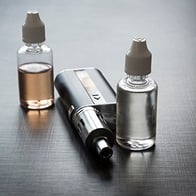 In the May 1, 2016 issue of Mass Spectrometry, researchers from Department of Molecular Biotechnology and Health Sciences at the Università degli Studi di Torino in Torino, Italy published a study about the chemical compositions and quality of e-liquids used in electronic cigarettes. The study used various analytical mass spectrometry (MS) methods to test for toxicity, including liquid chromatography-tandem MS “after a study of fragmentation pathways by high-resolution electrospray ionization (ESI)-MS.”
In the May 1, 2016 issue of Mass Spectrometry, researchers from Department of Molecular Biotechnology and Health Sciences at the Università degli Studi di Torino in Torino, Italy published a study about the chemical compositions and quality of e-liquids used in electronic cigarettes. The study used various analytical mass spectrometry (MS) methods to test for toxicity, including liquid chromatography-tandem MS “after a study of fragmentation pathways by high-resolution electrospray ionization (ESI)-MS.”
To test for the organic volatile toxicants, researchers sampled headspace from e-cigarette refill liquids using the purge-and-trap method for gas chromatography (GC)-MC analysis. The GC was equipped with a Teledyne Tekmar purge-and-trap concentrator. Additional MS methods included ultrahigh-pressure liquid chromatography and inductively coupled plasma-MS.
According to the researchers, “toxicity of e-cigarettes has not been completely clarified. They were introduced in the last 10 years to give smokers a healthier alternative to traditional cigarettes because of reduced burning (1,2). These devices, also known as electronic nicotine delivery systems (ENDS) use a battery to generate a weakly heated aerosol based on polyalcohols, such as propylene glycol and glycerol with a small amount of water, containing pharmaceutical-grade nicotine.”
The researchers used MS with different chromatographic and introduction techniques in order to evaluate for the greatest number of contaminants. The samples of the e-liquids were collected from four Italian producers and importers, and represented manufacturers from Italy, China, Poland and Germany.
The specific set-up for the GC-MS method was described as:
“To detect and quantify volatile organic compounds (VOCs) a Varian Saturn 3900 system (Agilent) was used. The GC was equipped with a Tekmar purge-and-trap concentrator (operating on a 25-mL aqueous sample from gas-tight vials) and a Varian 1177 injector. For GC separation we used a 30 m x 0.25 mm Varian VF624 column in a temperature interval between 35 °C and 250 °C. The injector temperature was 170 °C and injection was done in splitless mode. Helium gas at 1.2 mL/min was used as carrier. The MS analyzer was a Varian Saturn 2100 ion-trap system with an EI source, and full-scan spectra were acquired in the 45–400 m/z range.”
With the GC-MS method, researchers “searched for toxic glycols and semi-volatile organic components of methanol solutions of e-liquids.” The raw materials did not show any contamination. After analyzing the VOC fraction, researchers found “significant organic solvent contamination, including benzene, styrene, alkylbenzenes and ethanol.
For complete results of the study, visit ChromatographyOnline.com.
Blog updated on 7/3/2017 with link to new article posted relating to this study http://www.separationsnow.com/details/ezine/15ce3e586ec/E-liquids-hidden-alcohol-revealed-by-GC-protocol.html?&tzcheck=1
For more information on Teledyne Tekmar's Purge and Trap Concentrator and other instruments, visit www.teledynetekmar.com or contact us
